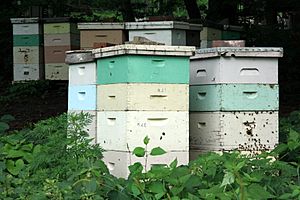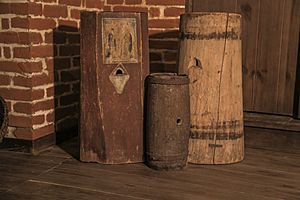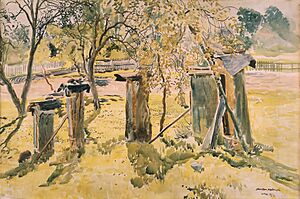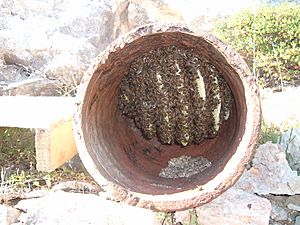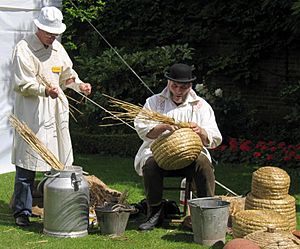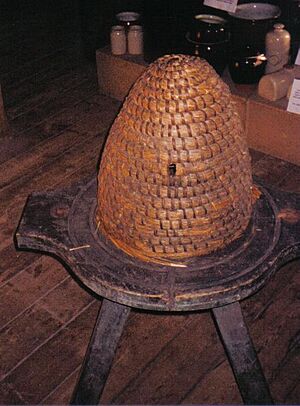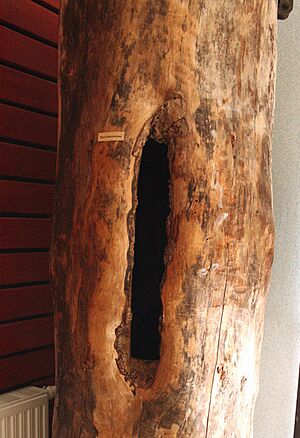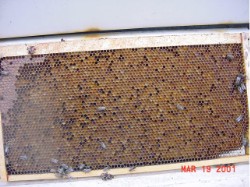Beehive facts for kids
A beehive is a special home where certain types of honey bees live and raise their young. Some beehives are built by the bees themselves in nature, like in hollow trees. These are called natural nests. Other beehives are made by people for domesticated honey bees. These man-made homes are usually what we mean when we say "beehive."
Inside a beehive, you'll find many small, six-sided (hexagonal) cells packed together. This amazing structure is called a honeycomb.
| Top - 0-9 A B C D E F G H I J K L M N O P Q R S T U V W X Y Z |
What is a Beehive?
A beehive is essentially a house for a bee colony. It's designed to keep the bees safe and help them store their food and raise their young. The most famous part of a beehive is the honeycomb, which is made of wax and has thousands of tiny hexagonal cells. Bees use these cells to store honey, pollen, and to raise baby bees.
Natural Bee Nests
Honey bees often build their natural nests in places like caves, cracks in rocks, or hollow trees. In warmer areas, they might even build nests that hang out in the open.
A natural nest is made of many honeycombs that hang parallel to each other. There's usually just one entrance. Western honey bees like nest spaces that are about 45 liters in size. They prefer entrances that face downwards and are usually between 1 and 5 meters (3 to 16 feet) off the ground. Bees often live in the same nest for many years.
Bees sometimes smooth the bark around their nest entrance. They also coat the inside walls with a thin layer of sticky plant resin called propolis. The honeycombs are attached to the walls, but small paths are left around the edges. In any honey bee nest, honey is stored at the top of the comb. Below that are cells for storing pollen, then cells for worker bees, and finally cells for drone bees. The special, peanut-shaped cells for the queen bee are usually built at the bottom edge of the comb.
Ancient Beehives
People have been keeping bees in man-made hives for a very long time. In ancient Egypt, over 4,400 years ago, there are pictures showing workers using smoke to collect honeycombs from hives. Later, around 650 BC, writings describe honey being stored in jars and in round, tube-shaped hives.
Old-Style Beehives
Early beehives simply gave bees a place to live. They didn't have any special parts inside. This meant the bees built their own honeycombs, which were often stuck to the hive walls. Because of this, the combs couldn't be moved without breaking them. These were sometimes called "fixed-frame" hives.
To get honey from these old hives, beekeepers usually had to crush the wax honeycomb. This process was called pressing. This method produced a lot of beeswax but much less honey compared to modern hives. Sometimes, harvesting honey would even destroy the entire bee colony.
There were four main types of old-style beehives: mud hives, clay/tile hives, skeps, and bee gums.
Mud and Clay Hives
Mud hives are still used in Egypt today. They are long, cylinder-shaped homes made from a mix of mud, straw, and animal waste.
In the eastern Mediterranean region, clay tiles were also used as bee homes. These were long, baked clay tubes. They were sometimes used alone or stacked in rows for shade. Beekeepers would smoke one end of the tube to make the bees move to the other end, allowing them to collect the honey.
Skeps
Skeps are basket-like beehives that have been used for about 2,000 years. They were first made from wicker covered with mud, but later they were made from coiled straw. Skeps usually have one opening at the bottom. Like other old-style hives, skeps didn't have internal structures, so bees built their combs attached to the inside.
Skeps had two main problems:
- Beekeepers couldn't easily check the combs for diseases or pests.
- Removing honey was hard and often meant destroying the whole colony.
To get honey, beekeepers sometimes drove the bees out or used special extensions called "ekes" or "caps" to encourage bees to build honey-only combs. Often, the bees were simply killed, sometimes using burning sulfur, to get the honeycomb. Many places in the US now do not allow skeps because they can't be inspected for diseases.
Some later skep designs had a small hole at the top where a smaller basket or glass jar could be placed. Bees would build comb in these, making it easier to collect some honey without harming the main colony. The person who made skeps was called a "skepper." Skeps are often seen as a symbol of hard work.
Bee Gums
In the eastern United States, especially in the southeast, people used hollow sections of trees as beehives until the 1900s. These were called "gums" because they often came from black gum trees.
These hollow tree sections were placed upright in "bee yards." Sometimes, sticks were put inside to give the bees a place to attach their honeycomb. Just like with skeps, harvesting honey from bee gums often meant destroying the colony. Beekeepers would sometimes kill the bees first by putting burning sulfur into the gum.
In Central Europe, hollowed-out tree trunks were also widely used. In Poland, such a hive was called a "barć." These were protected from bad weather and animals like bears. Harvesting honey from a "barć" usually didn't destroy the colony. Beekeepers would just remove a protective piece of wood and use smoke to move the bees away for a short time.
Bee gums are still used today for some bee species that don't produce as much honey as the common honeybee. They allow bees to build their nests naturally. Some beekeepers even use bee gums for honey-producing bees like the European dark bee to create a special, higher-priced honey.
Modern Hives
The first truly modern beehive designs appeared in the 1800s. These designs made it much easier to collect honey and manage the bees.
In 1814, Petro Prokopovych invented the world's first frame hive. This was a big step because it allowed beekeepers to remove honey without destroying the hive.
Today, there are two main types of modern hives:
- The movable-frame hive (like the Langstroth hive) has enclosed frames that hold the honeycomb.
- The movable-comb hive (like the top-bar hive) has only a top bar to support the comb.
Both types allow beekeepers to easily check for diseases and pests. They also make it simpler to divide a hive to create new bee colonies. Bees are more likely to build straight comb if the frames already have some comb or a guide.
Symbolism
The beehive has been a common symbol since Roman times. In the Middle Ages, it stood for hard work and industry.
Today, the beehive is used in groups like Freemasonry. There, it represents working together and being busy. It reminds people not to be lazy in their thinking.
The beehive also has a similar meaning for The Church of Jesus Christ of Latter-day Saints, also known as Mormons. Because of this, it has become one of the official state symbols of Utah.
Relocation
Many people think that smoke makes bees move their nest. But beekeepers use smoke to hide the alarm smell that bees release when they are disturbed. This makes the bees calmer during inspections.
If a bee colony is in an unwanted place, beekeepers can sometimes remove the nest. This process is called a "cut out." Once bees have built up honey, pollen, and wax, simply killing them is not a good solution. If the hive products are left behind, the wax and honey can melt and cause more problems later.
Destruction
By Other Animals
Black bears sometimes destroy beehives to get the honey inside.
In some parts of Africa, people use beehives as a defense against elephants. These hives are hung on a wire around farm fields. This setup, called a BeeHive Fence, helps protect crops from elephants.
By Humans
Humans sometimes destroy beehives to get honey and other bee products.
Sometimes, a beehive must be destroyed for public safety or to stop the spread of bee diseases. For example, in 1999, the US state of Florida destroyed hives of Africanized honey bees. In New Zealand, beekeepers must destroy hives infected with a disease called American foulbrood by burning them.
How Hives Are Destroyed
Spraying a hive with a mix of soap and water can be effective. The soap breaks down the waxy coating on the bees, which protects them from drowning. However, this should be done carefully, as it can make the bees angry.
Images for kids
-
A beekeeper inspects a hive frame with honeycomb, showing capped honey and brood cells. The modular design allows for easier management and non-destructive harvesting of honey and beeswax.
See also
 In Spanish: Colmena para niños
In Spanish: Colmena para niños


